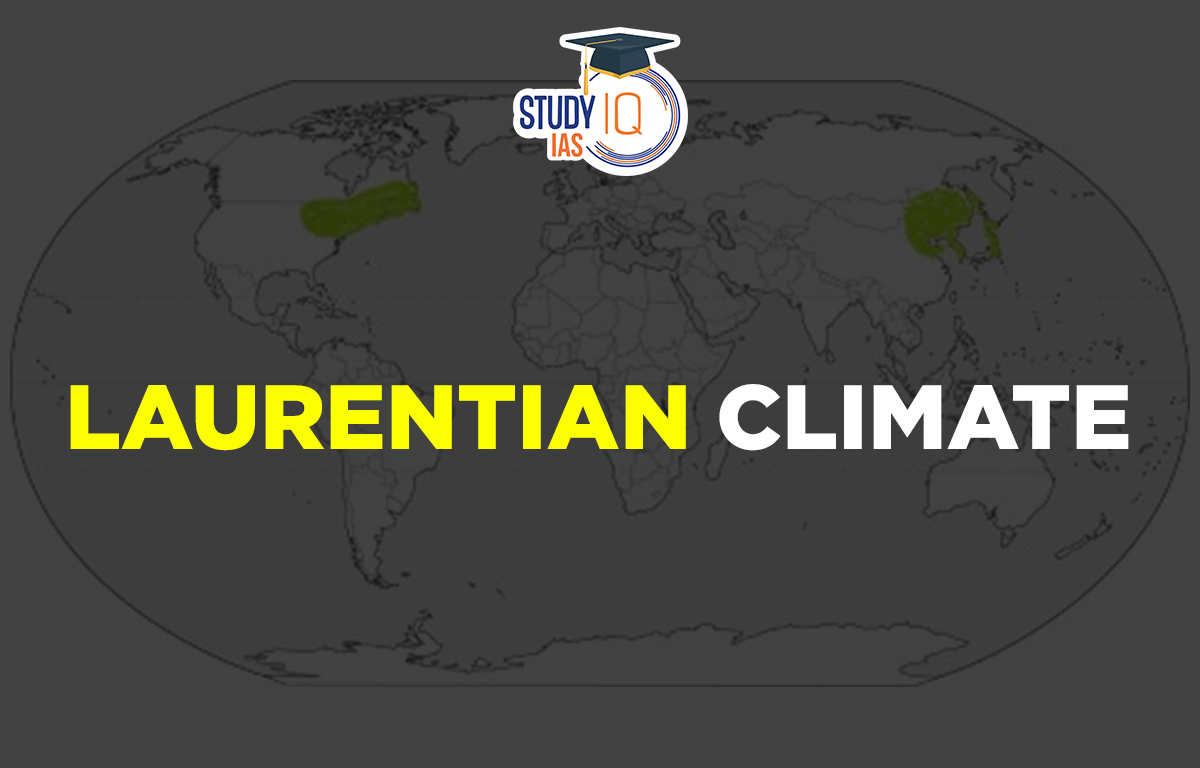Table of Contents
Laurentian Climate
The Laurentian climate in China is generally described as having a “Cool Temperate Monsoon Climate.” It has a big difference in temperature throughout the year and a very long, cold winter. In northern China, Korea, and Hokkaido, Japan, a lot of the winter precipitation comes as snow.
Read More: Climatology
Laurentian Climate Distribution Map
The cool Temperate Eastern Margin or Laurentian Climate is an intermediate type of climate between the British and Siberian climates. It has the characteristics of marine and continental climates. The Laurentian-type climate is found in only two areas:
- Northeastern North America includes eastern Canada, the northeastern U.S. (Maritime Provinces and New England), and Newfoundland.
- The Asian region encompasses eastern Siberia, northern China, Manchuria, Korea, and northern Japan; this climate type is absent in the Southern Hemisphere.
Read More: Equatorial Climate Region
Laurentian Climatic Conditions
The Laurentian climatic conditions are:
- The Laurentian climate has cold, dry winters and hot, humid summers.
- Winter temperatures are well below freezing, with heavy snow.
- Summer temperatures can reach as high as 21° – 27°C, becoming hotter without cold ocean currents.
- It gets 30 to 60 inches of rain each year, with most of it falling in the summer.
- Winters are dry and cold due to dry westerly winds from the continent’s interior.
Read More: Tropical Climate
Laurentian Climate Temperature
Cold, dry winters and hot, rainy summers define the climate. Snowfall during the winter is pretty normal given the below-freezing temperatures. The summers are about 25 °C, which is tropical warm.
Read More: Steppe Climate
Laurentian Climate Precipitation
Most of the rain falls in the summer, thanks to easterly winds from the oceans. The total rainfall each year ranges from 75 to 150 cm, with about two-thirds of that occurring in summer. In winter, dry winds from the interior of continents take over.
Read More: Precipitation
Laurentian Climate Natural Vegetation
The Laurentian natural vegetation are:
- The main vegetation in the Laurentian climate consists of cold temperate forests.
- High rainfall, warm summers, and fog help trees grow well.
- Trees include oak, beech, maple, and birch.
- Most forests north of 50° N latitude are coniferous.
- These coniferous forests continue the vast taiga belt found in eastern Siberia and Korea.
Read More: Natural Vegetation of India
Lumbering
The two main export commodities are fish and timber. The coniferous forests of fir, spruce, and larch are heavily exploited. The St. Lawrence River aids in export, but the heart of Canada’s timber and wood pulp sector is in Eastern Canada. Coniferous woodlands disappear south of latitude 50°N and are replaced by deciduous forests. The most prevalent trees are birch, oak, beech, and maple.
The commercial value of these forests is higher because most trees are the same species. This makes it easier to manage. Temperate hardwood trees have been cut down a lot for use. Both temperate hardwood and softwood come from areas with a Laurentian climate. In Manchuria, Korea, and Japan, forests have been cleared to make space for farming.
Read More: British Type of Climate
Laurentian Climate Life and Economy
The wood and allied wood, paper, and pulp industries are the most important activities. Agriculture is not as necessary due to the severity of winter and its length. Fortunately, the impact of the sea and heavy rainfall allow some hardy crops to be grown for local needs. Fertile Annapolis Valley, Nova Scotia has the most famous area for apples in the world. However, fishing is one of the most important economic activities in the Laurentian climate.
1. Economic Development
The main economic activity is lumber production, along with paper, pulp, and wood industries. Agriculture is less important due to long, harsh winters. Dairy farming is common across North America, and the Annapolis Valley in Nova Scotia is famous for its apples. However, fishing is the most significant economic activity.
2. Fishing in Japan
The northwestern Pacific, near Japan, is an important fishing area where many people depend on fishing for their livelihoods. Major fishing ports like Hakodate and Kushiro have good refrigeration facilities. Japanese fishing boats often go to the Arctic, Antarctic, and Atlantic oceans. Japan is criticized for its whaling activities in the Arctic and Antarctic. Each year, Japan catches about one-sixth of all fish caught worldwide. The Japanese also use seaweed, fish meal, and fish waste as fertilizers. Japan is one of the few countries that produce seaweed, with coastal farms growing it for food and other uses. Also, Japan practices pearl farming, where they cultivate pearls from oysters since wild pearls are hard to find.
Read More: China Type Climate
Laurentian Climate UPSC
The Laurentian climate can only be found in two locations, both in the northern hemisphere. The Laurentian climate is found in north-eastern North America, which includes eastern Canada, the northeastern United States, and Newfoundland. This is also referred to as the North American region. The winters are cold and dry, while the summers are hot and humid.
Winter temperatures are below freezing, and snowfall is common. Rainfall occurs all year, with a peak in the summer. The annual rainfall ranges from 75 to 150 cm. The landscape is dominated by cool temperate woodland.
The plentiful rains, hot summers, and wet air from fog all promote tree growth. Timber and seafood are the most popular exports. Much of the fir, spruce, and larch coniferous forest is heavily exploited. Lumbering, which includes the timber, paper, and pulp industries, is the most important economic enterprise. Agriculture is less important due to the long and harsh winters.
The continental shelf around Japan’s islands is rich in plankton and serves as a good breeding ground for a variety of fish due to the convergence of the warm Kuroshio and cold Oyashio currents.
Read More: Siberian Type Climate


 Story of Meera Bai and Her Devotion For ...
Story of Meera Bai and Her Devotion For ...
 Desert Climate, Distribution, Climatic C...
Desert Climate, Distribution, Climatic C...
 Deserts of India Map, Features of Thar D...
Deserts of India Map, Features of Thar D...





















